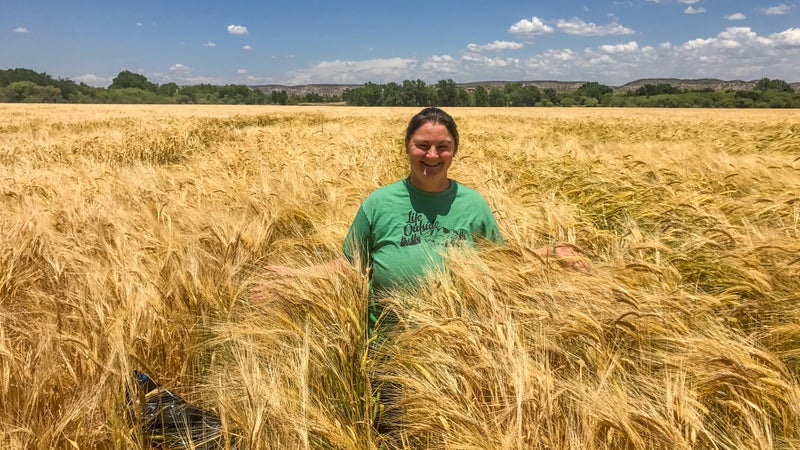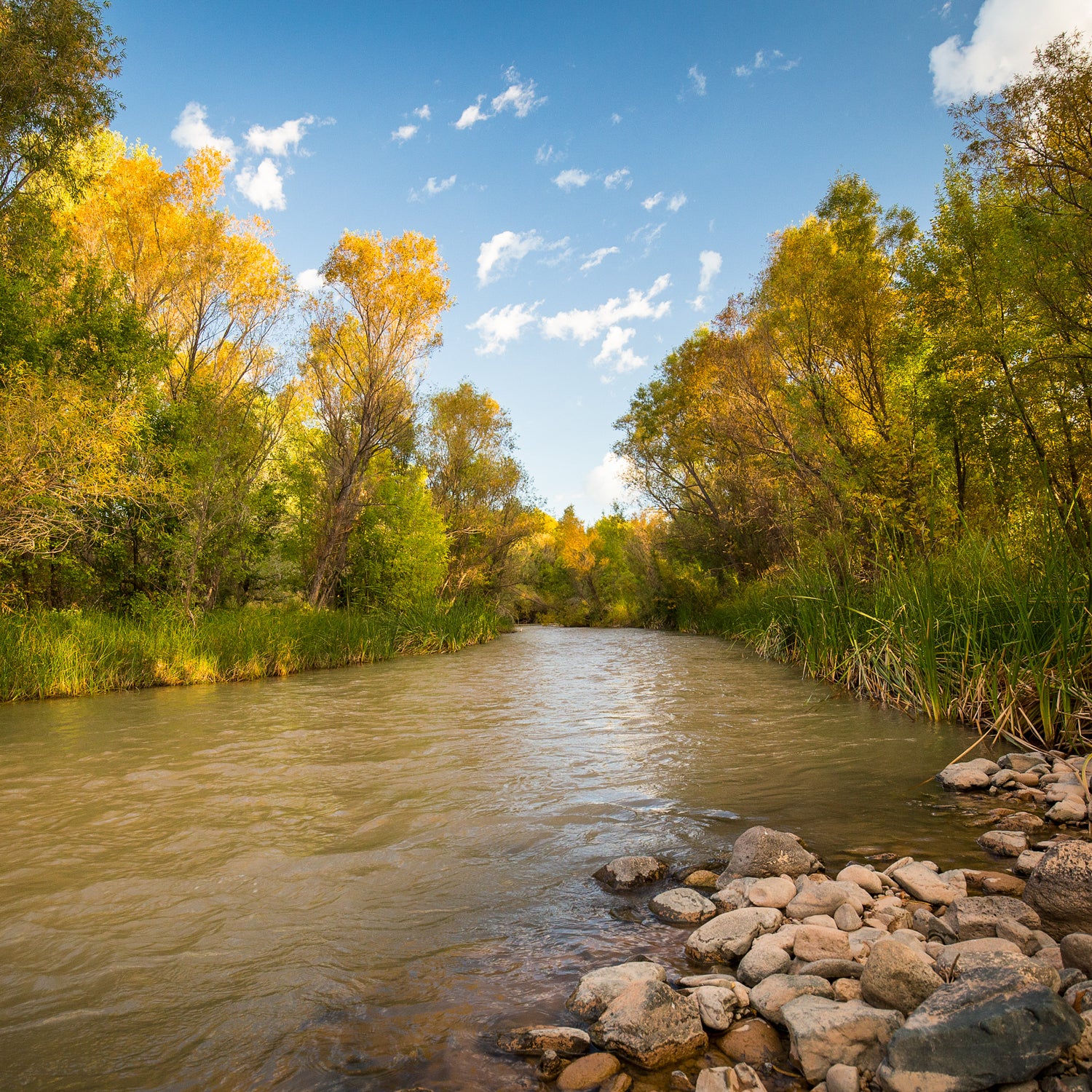Six summers ago, Kim Schonek, her husband, and an intern slid their kayaks into Arizona’s Verde River, a federally designated Wild and Scenic River. As they paddled, above them rose a rare cottonwood-willow canopy that teems with the densest population of tropical and native birds in North America. Half a mile into their trip, the river slowed, then dwindled to a trickle, until their kayaks scratched against the rocks. Schonek suggested they portage to the next flow. So they dragged their boats—for five miles.
“My husband was like, ‘I’m getting a divorce,’” Schonek says jokingly. “My intern was like, ‘I hate you, and I’m never boating again.’”
Schonek is the Verde River projects manager for the Nature Conservancy, so the prospect of a dry river presented a special problem. The 195-mile Verde River is a ribbon of green that cuts through parched canyons below Flagstaff down to the desert valley of Phoenix. It’s home to endangered fish, rare reptiles and amphibians, and 92 species of mammals. It’s a key tributary of the Lower Colorado River, which American Rivers named America’s Most Endangered River in 2017. Like many rivers that have landed on that endangered list—California’s San Joaquin, Colorado’s Upper Colorado, New Mexico’s Gila—the Verde is threatened by drought and excessive flow diversions, mainly to irrigate thirsty crops.
After the trip, Schonek started thinking about crop conversion, water-saving barley, and industries that might be motivated to save rivers. Eventually, she came up with a plan to keep the river flowing with the help of beer—an idea that, if it works, could help revive imperiled riparian areas throughout the Southwest.
On a cloudless day last December, Schonek drove me around the Verde Valley, her truck kicking up clouds of dust. The parched earth was a reminder of the months-long dearth of rain here and of the megadroughts researchers say loom in the Southwest’s future. We arrived at a diversion ditch, which siphons water from the Verde to flood crops like alfalfa.
Environmental organizations have for years encouraged farmers to convert to barley, which uses about half as much irrigation water as alfalfa and cotton. In the Southwest, this camel of crops could be especially beneficial, because it keeps water in rivers at the right time. Barley is planted in January; irrigated in spring, when rivers are flush; and harvested in June, when water is scarce. Converting just one-tenth of Verde Valley crops to barley would keep 200 million gallons of water flowing in the Verde River each summer.
But farmers have hesitated to switch for a simple reason: money. Barley’s most common use is for animal feed, which is a money-loser. So when Schonek was devising a way to save the Verde, she thought of a way to raise local barley prices by pairing farmers with an industry that uses a lot of barley and a lot of water: breweries.
“It’s kind of a new conservation technique,” Schonek says. “Instead of paying farmers every year to reduce the water they’re using, we can create a market that will drive farmers to change their water use.”
Beer-destined barley pays 50 percent more than feed barley, which would definitely help motivate farmers to switch. But the plan had its risks. Most of the barley used in U.S. craft beers comes from Canada and Europe, and Arizona doesn’t have an established barley industry. Schonek would have to make one, and she’d also have to convince farmers that the long-run financial benefits outweighed the financial hit some might take in the transition period. Fortunately, over the previous years, Schonek had created cooperative relationships with farmers in the area and had already persuaded many to replace the inefficient river-diversion gates—which farmers operated by jumping on—with automated gates that saved millions of gallons of water a day. Schonek was currently working with them to transition to drip irrigation. And it was this trust—plus the benefit of the Nature Conservancy’s financial backing—that helped her convince farmers to start Arizona’s first beer barley industry.

“We care about the river; it’s the only reason there’s farming here in the first place,” says farmer Zach Hauser, whose family owns the largest swath of farmland in the Verde Valley. “We have a huge interest in the health of the river, so anything we can do while still making a living is a win-win.”
Schonek brought in experts to teach the Hausers to grow Harrington two-row barley, and the Nature Conservancy agreed to subsidize any losses during the experimental years. Last season, the Hausers planted 144 acres of barley, some of which was sold to Arizona Wilderness Brewing Co. The brewers were so excited to have river-saving local barley that they plan to completely switch.
“Brewing is a water-intensive activity,” says Chase Saraiva, head brewer at Arizona Wilderness. “It’s pretty much a water sport, so we need to be conscious of where our water is coming from and be proactive in taking measures to help in any way we can.”
But there was one missing link: malting. Because there are hardly any malting facilities in the West, they had to malt that first batch of barley in Texas. That’s not sustainable, so Schonek teamed up with Chip Norton, board vice president of Many Rivers Brewing in Colorado, which contributes all of its profits to saving rivers. Together, next month, they will launch Sinagua Malt, a local malting facility that will dedicate profits to river conservation.
When Schonek drove me around the Verde Valley, the elements of the project were nearly in place. The Hausers’ loamy fields were ready to be sown. Next to their barns, plastic-draped malting equipment and a silo of nutty-scented raw barley waited for construction to be completed on the Sinagua Malt warehouse in Camp Verde. “The potential for a market-solution approach to crop conversion exists in lots of tributaries in the Colorado River Basin,” says Norton, holding up a handful of barley. “A lot of people are pretty excited about this, and they’re watching us closely to see if it’ll work as a way to improve stream flow and improve the flow of the Colorado River.”
If the plan works, it will be the first time an environmental organization has created a new market for the purpose of river preservation—and there’s evidence that it’s already making a difference. Last July, Schonek and her family returned to that same five-mile stretch of dry Verde River. This time, they paddled the entire way.


